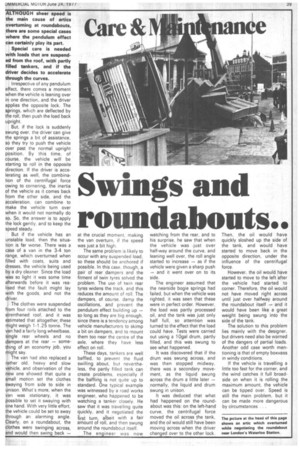Swings and roundabouts..
Page 41

If you've noticed an error in this article please click here to report it so we can fix it.
at the crucial moment, making the van overturn, if the speed was just a bit high.
The same problem is likely to occur with any suspended load, so these should be anchored if possible. In this case, though, a pair of rear dampers and the fitment of twin tyres solved the problem. The use of twin rear tyres widens the track, and this reduces the amount of roll. The dampers, of course, damp the oscillations, and prevent the pendulum effect building up — so long as they are big enough, since there is a tendency among vehicle manufacturers to skimp a bit on dampers, and to mount them too near the centre of the axle, where they have less effect on roll.
These days, tankers are well baffled, to prevent the fluid swilling about, but nevertheless, the partly filled tank can create problems, especially if the baffling is not quite up to standard. One typical example was witnessed by a road works engineer, who happened to be watching a tanker closely He saw that it was travelling quite quickly, and it negotiated the iirsi turn, ilbeit with a fair amount of roll, and then swung around the roundabout itself, The engineer was now
watching from the rear, and to his surprise, he saw that when the vehicle was •just over half-way around the curve, and leaning well over, the roll angle started to increase -as if the vehicle were given a sharp push and it went over on to its side.
The engineer assumed that the nearside bogie springs had failed, but when the vehicle was righted, it was seen that these were in perfect order. However, the load was partly processed oil, and the tank was just only half full, so attention was turned to the effect that the load could have. Tests were carried out using a 10gal drum, partly filled, and this was swung to see what happened.
It was discovered that if the drum was swung across, and was then stopped midway, there was a secondary movement, as the liquid swung across the drum a little later — .normally, the liquid and drum swung in unison.
It was deduced that what had happened on the roundabout was this: on the left-hand curve, the centrifugal force moved the oil across the tank, and the oil would still have been moving across when the driver changed over to the other lock. Then, the oil would have quickly sloshed up the side of the tank, and would have started to move back in the opposite direction, under the influence of the centrifugal force.
However, the oil would have started to move to the left after the vehicle had started to corner. Therefore, the oil would not have moved right across until just over halfway around the roundabout itself -and it would have been like a great weight being swung into the side of the tank.
The solution to this problem lies mainly with the designer, but drivers need also be warned of the dangers of partial loads. Another odd case worth mentioning is that of empty boxyans in windy conditions.
If the vehicle is travelling a little too fast for the corner, and the wind catches it full broadside on when it is rolling the maximum amount, the vehicle can be tipped over. Speed is still the main problem, but it can be made more dangerous by circumstances . .




































































































